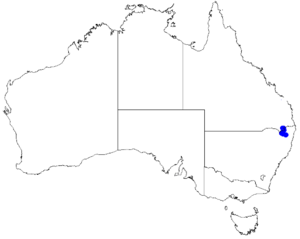Boronia inflexa facts for kids
Quick facts for kids Boronia inflexa |
|
|---|---|
| Scientific classification | |
| Genus: |
Boronia
|
| Species: |
inflexa
|
 |
|
| Occurrence data from Australasian Virtual Herbarium | |
Boronia inflexa is a special plant found only in a small area of Australia. It belongs to the citrus family, called Rutaceae. This plant grows on the tablelands near the border between New South Wales and Queensland.
It's a woody shrub that stands upright. Its leaves are shaped like feathers (this is called pinnate). It has beautiful white to pink flowers, usually with four petals. These flowers grow where the leaves meet the stem.
What it Looks Like
Boronia inflexa is an upright, woody shrub. It can grow up to about 2 meters (6.5 feet) tall. It can also spread out to about 3 meters (10 feet) wide.
Its leaves are made up of smaller leaflets, like a feather. The whole leaf can be from 6 to 25 millimeters (0.2 to 1 inch) long. The stem that holds the leaf is about 3 to 10 millimeters (0.1 to 0.4 inches) long.
The flowers are white or pink. They grow in groups of up to seven. Each flower has four sepals, which are small, green leaf-like parts at the base of the flower. These sepals are mostly smooth.
The four petals are about 2.5 to 7.5 millimeters (0.1 to 0.3 inches) long. Sometimes they have a few tiny hairs. The flower has eight hairy stamens, which are the parts that produce pollen.
Boronia inflexa flowers mostly from June to December. After flowering, it produces small fruits. These fruits are about 3 to 3.5 millimeters (0.12 to 0.14 inches) long.
Plant Name and History
Boronia inflexa was first officially described in 2003. A scientist named Marco F. Duretto gave it its formal description. He published his findings in a science journal called Muelleria. The first plant he studied was found in Girraween National Park.
The second part of its name, inflexa, comes from a Latin word. It describes how the edges of the sepals (the small leaf-like parts under the petals) bend inwards near their tips.
In the same paper, Duretto also described four different types, or subspecies, of Boronia inflexa:
- Boronia inflexa subsp. inflexa: This type has tiny, soft hairs on its branches and leaves. Its petals are about 2 to 3.5 millimeters long.
- Boronia inflexa subsp. montiazura: This type is smooth, without hairs. Its end leaflet is about 3 to 7 millimeters long.
- Boronia inflexa subsp. grandiflora: This type also has tiny, soft hairs on its branches and leaves. Its petals are larger, about 6.5 to 7 millimeters long.
- Boronia inflexa subsp. torringtonensis: This type is smooth, without hairs. Its end leaflet is longer, about 10 to 16 millimeters long.
Where it Grows
This boronia plant likes to grow in areas with granite rock and soil made from granite. You can find it in open woodlands, forests, and heathlands.
The subspecies inflexa grows between Stanthorpe and the Girraween National Park in Queensland. It also grows in a separate area, the Gibraltar Range National Park in New South Wales. Another subspecies grows on a small hill near Applethorpe.
Subspecies grandiflora is found near Amiens and Lyra. The subspecies torringtonensis is only found in the Torrington area of New South Wales.
Looking After the Plant
One type of this plant, Boronia inflexa subsp. montiazura, is listed as "least concern" by the Queensland Government. This means it is not currently at high risk of disappearing.

